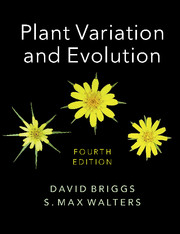Book contents
- Frontmatter
- Contents
- Preface to the Fourth Edition
- Acknowledgements
- Note on names of plants
- List of abbreviations
- 1 Investigating plant variation and evolution
- 2 From Ray to Darwin
- 3 Early work on biometry
- 4 Early work on the basis of individual variation
- 5 Post-Darwinian ideas about evolution
- 6 DNA: towards an understanding of heredity and molecular evolution
- 7 Breeding systems
- 8 Intraspecific variation and the ecotype concept
- 9 Pattern and process in plant populations
- 10 Pattern and process: factors interacting with natural selection
- 11 Populations: origins and extinctions
- 12 Species and speciation: concepts and models
- 13 Allopatric speciation and hybridisation
- 14 Abrupt speciation
- 15 The species concept
- 16 Flowering plant evolution: advances, challenges and prospects
- 17 Historical biogeography
- 18 The evolutionary impact of human activities
- 19 The taxonomic challenge ahead
- 20 Conservation: from protection to restoration and beyond
- Glossary
- References
- Index
3 - Early work on biometry
Published online by Cambridge University Press: 05 June 2016
- Frontmatter
- Contents
- Preface to the Fourth Edition
- Acknowledgements
- Note on names of plants
- List of abbreviations
- 1 Investigating plant variation and evolution
- 2 From Ray to Darwin
- 3 Early work on biometry
- 4 Early work on the basis of individual variation
- 5 Post-Darwinian ideas about evolution
- 6 DNA: towards an understanding of heredity and molecular evolution
- 7 Breeding systems
- 8 Intraspecific variation and the ecotype concept
- 9 Pattern and process in plant populations
- 10 Pattern and process: factors interacting with natural selection
- 11 Populations: origins and extinctions
- 12 Species and speciation: concepts and models
- 13 Allopatric speciation and hybridisation
- 14 Abrupt speciation
- 15 The species concept
- 16 Flowering plant evolution: advances, challenges and prospects
- 17 Historical biogeography
- 18 The evolutionary impact of human activities
- 19 The taxonomic challenge ahead
- 20 Conservation: from protection to restoration and beyond
- Glossary
- References
- Index
Summary
In the second half of the nineteenth century, as Darwinism was making its impact upon biology, an interesting new approach to biological variation, especially intraspecific variation, was being examined. Instead of trying to describe variation patterns in words, the investigators, examining large samples of organisms, collected numerical data and subjected them to statistical analysis. In the following account we discuss selected themes: for comprehensive studies of the subject see Pearson & Kendall (1970), Kendall & Plackett (1977), Porter (1986) and Stigler (1986).
The first worker to study natural variation statistically, a science that became known as biometry, was probably the Belgian Quetelet (1796–1874). He wrote a famous series of letters on the subject to his pupil, the Grand Duke of Saxe-Coburg and Gotha. Later in the century, Darwin's cousin, Francis Galton (1822–1911), made notable contributions to the statistical investigation of variation and inheritance, ideas that were developed by many other investigators, especially in relation to social issues (see Bowler, 1989; Keynes, 1993; Gillham, 2001; Bulmer, 2003).
Biometrics and eugenics
While Darwin and others considered humankind to be a single species, others, for example the American biologist Louis Agassiz (1807–73), took the view that there were several species of humans. In the developing fields of anthropology and sociology, biometrical methods were increasingly employed to examine racial variation.
Darwinian concepts provoked many questions with social implications. In 1871, in his book The Descent of Man, Darwin wrote:
With savages, the weak in body or mind are soon eliminated; and those that survive commonly exhibit a vigorous state of health. We civilized men, on the other hand, do our utmost to check the process of elimination; we build asylums for the imbecile, the maimed, and the sick; we institute poor-laws; and our medical men exert their utmost skill to save the life of every one to the last moment … Thus the weak members of civilised societies propagate their kind. No one who has attended to the breeding of domestic animals will doubt that this must be highly injurious to the race of man.
(Darwin, 1871)Darwin continues:
The surgeon may harden himself whilst performing an operation, for he knows that he is acting for the good of his patient; but if we were intentionally to neglect the weak and helpless, it could only be for a contingent benefit, with a great and certain present evil.
- Type
- Chapter
- Information
- Plant Variation and Evolution , pp. 23 - 36Publisher: Cambridge University PressPrint publication year: 2016

